G.D. Ehret & C.J.Trew
Plantae Selectae, Nuremberg, 1750-1753
Please scroll down for bibliographic information
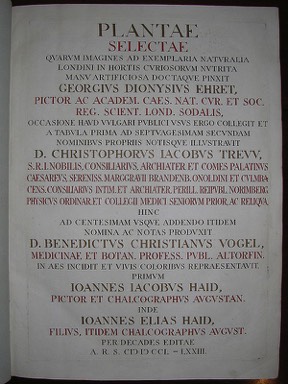
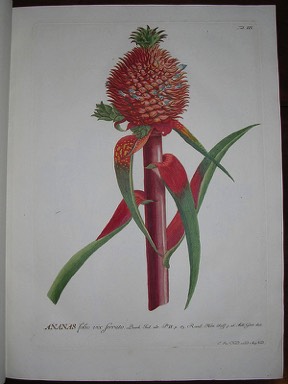
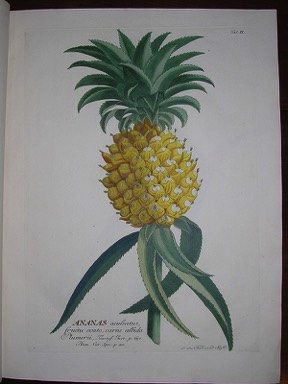
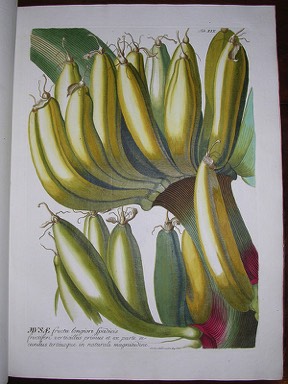
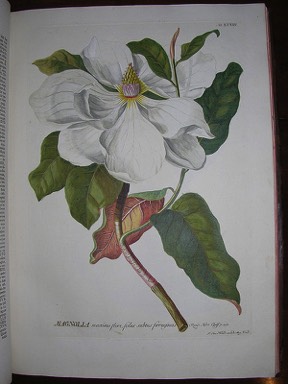
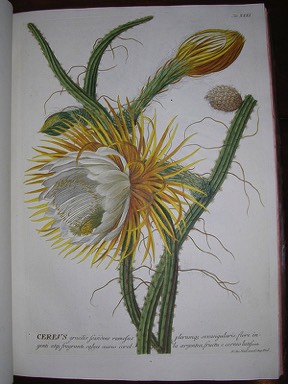
TREW, Christoph Jakob (1695-1769) - EHRET, Georg (1708-1770).
Plantae selectae quarum imagines ad exemplaria naturalia Londini, in hortis curiosorum nutritamanu artificiosa doctaque pinxit Georgius Dionysius Ehret. Nuremberg, 1750-1773.
Two volumes. Folio (20 x 13 5/8 inches). Fine engraved general title-page HEIGHTENED IN RED AND GOLD (issue without the sectional title-pages), 3 mezzotint portraits of Trew, G.D. Ehret, and J. J. Haid, 100 MAGNIFICENT hand-colored engraved plates after Georg Dionysius Ehret by Johann Jakob Haid, each with the first word of the caption HEIGHTENED IN GOLD. Contemporary calf, decorated with geometric ornaments. First edition, and the magnum opus of the long and fruitful collaboration between Trew and Georges Ehret, and Trew. Ehret traveled widely, sending back hundreds of botanical drawings and paintings, which were included in the present work. For "Plantae Selectae", the level of botanical interest and exotic appeal were how the two chose which illustrations to use. They had to decide on a way to present these tropical subjects to the public that had only recently been introduced to Europe. Johannes Jacobus and Johannes Elias Haid translated Ehret's exceptional and remarkably sensuous watercolors into hand-colored engravings that represented everything Ehret's work was about. Ehret had met Linnaeus in 1736 and the latter's work moved the artist to analyze the structure of the plant before trying to represent it. The Latin text was written by Trew and describes each plant, the history of its discovery and additional comments. Each species is compared with descriptions written by other botanical authors in order to definitively classify each plant. This great work was not finished until after Ehret's death, though his instructions were followed as to the layout. Linnaeus praised this work in a letter to Trew, calling it one of the great miracles of the century.
THE MAJORITY OF THE PLATES IN EHRET'S MAGNUM OPUS ARE EXOTIC SPECIES NATIVE TO THE AMERICAS:
Plate II. Ananas aculeatus, or the Hawaiian Pineapple
Plate III. Ananas folio vix ferato, or the Red Pineapple, native to Brazil
Plate IV. Bocconia racemosa , or Tree Celandine, native to Jamaica
Plate V. Anona fructu lutescente, a relative of the Custard Apple, native to the West Indies, Central America and Mexico
Plate VI. Araliastrum foliis ternis quinquepartitus, or Ginseng, native to Asia and to Canada
Plate VII. Papaya, native to Central America and Mexico
Plate VIII, LVII. Species of Corallodendron, or Flame Tree, or American Coral Tree, found throughout the tropics
Plate IX. Magnolia Lauri folio, or Sweet-flowering Bay, native to the Atlantic Coast of America
Plate X. Liriodendrum, or Tulip Tree, native to Eastern America
Plate XI. Lilium foliis Sparsis, or Tiger Lily, native to Western America
Plate XII. Meadia, or Eastern Shooting Star, native to the Eastern and Central United States
Plates XIV, XXX, XXXI, XXII, all species of Cereus, or cactus, native to the Western United States, Mexico and South America
Plate XV. Pavia, or Scarlet Buckeye, native from North Carolina south to Florida, west to central Texas, and as far north as Illinois
Plate XVII. Mespilus, or May Hawthorne, native from South Carolina, south to northern Florida, west through the Gulf states to southern Arkansas and the valley of the Sabine river, Texas
Plates XVIII, XIX, XX, XXI, XXII, XXIII, all species of Banana, while technically an import, found throughout the West Indies at the time this book was published
Plates XXIV, LXVIII. Species of Lycium, a member of the Nightshade family, found throughout America
Plate XXIX. Podophyllum, or Mayapple, widespread across most of the eastern United States and southeastern Canada
Plate XXXIII. Magnolia maximo flore, or Magnolia Grandiflora, native to the southeastern United States, from Virginia south to central Florida, and west to East Texas and Oklahoma
Plates XXIV, XXIV. Hura, or Sandbox Tree, native to tropical regions of North and South America, including the Amazon Rainforest
Plate XXXVI. Acacia non spinosa, or Prairie Wattle, native to southern parts of North America, the Caribbean and the majority of South America
Plate XXXVII. Yucca, native to the hot and dry (ie arid) parts of North America, Central America, South America, and the Caribbean
Plate XXXVIII. Ledum, or Mountain Laurel, native to north-eastern North America, southern Maine south to northern Florida, and west to Indiana and Louisiana
Plate XLI. Plumeria, or Frangipani, native to Central America, Mexico, the Caribbean, and South America as far south as Brazil
Plate XLIII. Guiaba, or Guava, native to Mexico, Central America, and northern South America
Plate XLV. Heliocarpus, sometimes called Majaguillo, native to Central America
Plate XLVI. Tacamahaca, or Balsam Poplar, or Balm-of Gilead, native to most of the Northern United States and Canada
Plate XLVIII. Azalea scapo nudo, or Sweet Azalea, first described by John Bartram in 1814, native to the eastern United States
Plate XLIX. Guanabanus, or Soursop, native to Mexico, Cuba, Central America, the Caribbean, and northern South America, primarily Colombia, Brazil, Peru, Ecuador, Venezuela, and Puerto Rico
Plate L. Bromelia, native to tropical Americas
Plates LIII, LIV, LV. Species of Indigofera, or Indigo plant, technically and import, but grown widely in the West Indies and Carolinas when this book was published
Plate LIX, LXV. Sophora, or Pea-flower, found in western South America, the western United States, Florida and Puerto Rico
Plate LXII, LXIII. Magnolia, or Umbrella Magnolia, native to the southeastern United States in the Appalachian Mountains region
Plate LXIV. Monarda, or Wild Bergamot, native throughout Canada, the United States and Mexico
Plate LXVI. Rhododendrum, or Carolina Rhododendron, native to eastern North America, particularly Virginia and North Carolina
Plate LXVII. Petivera, or Pokeweed, native to Florida and the Lower Rio Grande Valley of Texas in the United States, Mexico, Central America, the Caribbean, and tropical South America
Plate LXIX, LXX. Laurus, or Sassafras tree, native to northeastern America
Plate LXXVI. Theabroma [sic], or Cacao, native to the tropical forests of Central and South America, and used to make chocolate
Plate LXXVII. Veratrum, or Helonias, or Swamp Pink, a rare perennial rhizomatous herb native to the eastern United States
Plate LXXVIII. Urtica, or Stinging Nettle, native to North America
Plate LXXXI. Melanthium, or Bunch Flower, native to North America
Plate LXXXIII. Pontederia, or Pickerel Weed, found throughout the Americas
Plate LXXXV. Acer, or Sugar-Maple, native to the hardwood forests of northeastern Canada, from Nova Scotia west through Quebec and southern Ontario to south eastern Manitoba around Lake of the Woods. In the USA, the species is common from Minnesota, to the New England states of Maine, Vermont, New Hampshire, Massachusetts, Connecticut, and Rhode Island, and down to the Eastern seaboard states of New York, New Jersey, and Pennsylvania. They are also found as far south as Georgia and Texas
Plate LXXXVI. Acer, possibly the Red Maple, one of the most common and widespread deciduous trees of eastern North America.
Plate LXXXVIII. Chelone, or White Turtlehead, native to eastern North America
Plate LXXXIX. Sida, or 'Ilima, from Hawaii
Plate XC. Abutilon, or Sweet Pelotazo, or Indian mallow, native to the American tropics
Plate XCIV. Ceanothus, of California Lilac, native to North America and found most commonly in California
Plate XCV. Mimosa sensitiva, (although the leaves are depicted incorrectly), native to Central America
Plate XCVIII. Itea Virginica, or Virginia Sweetspire, native to the southern United States from New Jersey to Texas
Plate XCIX. Ellisia Nyctelea, or Aunt Lucy, endemic throughout the United States
Plate C. Iris, or Rainbow Iris, native to California
Like his father before him Ehret trained as a gardener, initially working on estates of German nobility, and painting flowers only occasionally, another skill taught him by his father, who was a good draughtsman. Ehret’s “first major sale of flower paintings came through Dr Christoph Joseph Trew, eminent physician and botanist of Nuremberg, who recognized his exceptional talent and became both patron and lifelong friend. Ehret sent him large batches of watercolours on the fine-quality paper Trew provided. In 1733 Trew taught Ehret the botanical importance of floral sexual organs and advised that he should show them in detail in his paintings. Many Ehret watercolours were engraved in Trew's works, such as ‘Hortus Nitidissimus’ (1750–86) and ‘Plantae selectae' (1750–1773) [as here], in part two of which (1751) Trew named the genus Ehretia after him. Sold.
Plantae selectae quarum imagines ad exemplaria naturalia Londini, in hortis curiosorum nutritamanu artificiosa doctaque pinxit Georgius Dionysius Ehret. Nuremberg, 1750-1773.
Two volumes. Folio (20 x 13 5/8 inches). Fine engraved general title-page HEIGHTENED IN RED AND GOLD (issue without the sectional title-pages), 3 mezzotint portraits of Trew, G.D. Ehret, and J. J. Haid, 100 MAGNIFICENT hand-colored engraved plates after Georg Dionysius Ehret by Johann Jakob Haid, each with the first word of the caption HEIGHTENED IN GOLD. Contemporary calf, decorated with geometric ornaments. First edition, and the magnum opus of the long and fruitful collaboration between Trew and Georges Ehret, and Trew. Ehret traveled widely, sending back hundreds of botanical drawings and paintings, which were included in the present work. For "Plantae Selectae", the level of botanical interest and exotic appeal were how the two chose which illustrations to use. They had to decide on a way to present these tropical subjects to the public that had only recently been introduced to Europe. Johannes Jacobus and Johannes Elias Haid translated Ehret's exceptional and remarkably sensuous watercolors into hand-colored engravings that represented everything Ehret's work was about. Ehret had met Linnaeus in 1736 and the latter's work moved the artist to analyze the structure of the plant before trying to represent it. The Latin text was written by Trew and describes each plant, the history of its discovery and additional comments. Each species is compared with descriptions written by other botanical authors in order to definitively classify each plant. This great work was not finished until after Ehret's death, though his instructions were followed as to the layout. Linnaeus praised this work in a letter to Trew, calling it one of the great miracles of the century.
THE MAJORITY OF THE PLATES IN EHRET'S MAGNUM OPUS ARE EXOTIC SPECIES NATIVE TO THE AMERICAS:
Plate II. Ananas aculeatus, or the Hawaiian Pineapple
Plate III. Ananas folio vix ferato, or the Red Pineapple, native to Brazil
Plate IV. Bocconia racemosa , or Tree Celandine, native to Jamaica
Plate V. Anona fructu lutescente, a relative of the Custard Apple, native to the West Indies, Central America and Mexico
Plate VI. Araliastrum foliis ternis quinquepartitus, or Ginseng, native to Asia and to Canada
Plate VII. Papaya, native to Central America and Mexico
Plate VIII, LVII. Species of Corallodendron, or Flame Tree, or American Coral Tree, found throughout the tropics
Plate IX. Magnolia Lauri folio, or Sweet-flowering Bay, native to the Atlantic Coast of America
Plate X. Liriodendrum, or Tulip Tree, native to Eastern America
Plate XI. Lilium foliis Sparsis, or Tiger Lily, native to Western America
Plate XII. Meadia, or Eastern Shooting Star, native to the Eastern and Central United States
Plates XIV, XXX, XXXI, XXII, all species of Cereus, or cactus, native to the Western United States, Mexico and South America
Plate XV. Pavia, or Scarlet Buckeye, native from North Carolina south to Florida, west to central Texas, and as far north as Illinois
Plate XVII. Mespilus, or May Hawthorne, native from South Carolina, south to northern Florida, west through the Gulf states to southern Arkansas and the valley of the Sabine river, Texas
Plates XVIII, XIX, XX, XXI, XXII, XXIII, all species of Banana, while technically an import, found throughout the West Indies at the time this book was published
Plates XXIV, LXVIII. Species of Lycium, a member of the Nightshade family, found throughout America
Plate XXIX. Podophyllum, or Mayapple, widespread across most of the eastern United States and southeastern Canada
Plate XXXIII. Magnolia maximo flore, or Magnolia Grandiflora, native to the southeastern United States, from Virginia south to central Florida, and west to East Texas and Oklahoma
Plates XXIV, XXIV. Hura, or Sandbox Tree, native to tropical regions of North and South America, including the Amazon Rainforest
Plate XXXVI. Acacia non spinosa, or Prairie Wattle, native to southern parts of North America, the Caribbean and the majority of South America
Plate XXXVII. Yucca, native to the hot and dry (ie arid) parts of North America, Central America, South America, and the Caribbean
Plate XXXVIII. Ledum, or Mountain Laurel, native to north-eastern North America, southern Maine south to northern Florida, and west to Indiana and Louisiana
Plate XLI. Plumeria, or Frangipani, native to Central America, Mexico, the Caribbean, and South America as far south as Brazil
Plate XLIII. Guiaba, or Guava, native to Mexico, Central America, and northern South America
Plate XLV. Heliocarpus, sometimes called Majaguillo, native to Central America
Plate XLVI. Tacamahaca, or Balsam Poplar, or Balm-of Gilead, native to most of the Northern United States and Canada
Plate XLVIII. Azalea scapo nudo, or Sweet Azalea, first described by John Bartram in 1814, native to the eastern United States
Plate XLIX. Guanabanus, or Soursop, native to Mexico, Cuba, Central America, the Caribbean, and northern South America, primarily Colombia, Brazil, Peru, Ecuador, Venezuela, and Puerto Rico
Plate L. Bromelia, native to tropical Americas
Plates LIII, LIV, LV. Species of Indigofera, or Indigo plant, technically and import, but grown widely in the West Indies and Carolinas when this book was published
Plate LIX, LXV. Sophora, or Pea-flower, found in western South America, the western United States, Florida and Puerto Rico
Plate LXII, LXIII. Magnolia, or Umbrella Magnolia, native to the southeastern United States in the Appalachian Mountains region
Plate LXIV. Monarda, or Wild Bergamot, native throughout Canada, the United States and Mexico
Plate LXVI. Rhododendrum, or Carolina Rhododendron, native to eastern North America, particularly Virginia and North Carolina
Plate LXVII. Petivera, or Pokeweed, native to Florida and the Lower Rio Grande Valley of Texas in the United States, Mexico, Central America, the Caribbean, and tropical South America
Plate LXIX, LXX. Laurus, or Sassafras tree, native to northeastern America
Plate LXXVI. Theabroma [sic], or Cacao, native to the tropical forests of Central and South America, and used to make chocolate
Plate LXXVII. Veratrum, or Helonias, or Swamp Pink, a rare perennial rhizomatous herb native to the eastern United States
Plate LXXVIII. Urtica, or Stinging Nettle, native to North America
Plate LXXXI. Melanthium, or Bunch Flower, native to North America
Plate LXXXIII. Pontederia, or Pickerel Weed, found throughout the Americas
Plate LXXXV. Acer, or Sugar-Maple, native to the hardwood forests of northeastern Canada, from Nova Scotia west through Quebec and southern Ontario to south eastern Manitoba around Lake of the Woods. In the USA, the species is common from Minnesota, to the New England states of Maine, Vermont, New Hampshire, Massachusetts, Connecticut, and Rhode Island, and down to the Eastern seaboard states of New York, New Jersey, and Pennsylvania. They are also found as far south as Georgia and Texas
Plate LXXXVI. Acer, possibly the Red Maple, one of the most common and widespread deciduous trees of eastern North America.
Plate LXXXVIII. Chelone, or White Turtlehead, native to eastern North America
Plate LXXXIX. Sida, or 'Ilima, from Hawaii
Plate XC. Abutilon, or Sweet Pelotazo, or Indian mallow, native to the American tropics
Plate XCIV. Ceanothus, of California Lilac, native to North America and found most commonly in California
Plate XCV. Mimosa sensitiva, (although the leaves are depicted incorrectly), native to Central America
Plate XCVIII. Itea Virginica, or Virginia Sweetspire, native to the southern United States from New Jersey to Texas
Plate XCIX. Ellisia Nyctelea, or Aunt Lucy, endemic throughout the United States
Plate C. Iris, or Rainbow Iris, native to California
Like his father before him Ehret trained as a gardener, initially working on estates of German nobility, and painting flowers only occasionally, another skill taught him by his father, who was a good draughtsman. Ehret’s “first major sale of flower paintings came through Dr Christoph Joseph Trew, eminent physician and botanist of Nuremberg, who recognized his exceptional talent and became both patron and lifelong friend. Ehret sent him large batches of watercolours on the fine-quality paper Trew provided. In 1733 Trew taught Ehret the botanical importance of floral sexual organs and advised that he should show them in detail in his paintings. Many Ehret watercolours were engraved in Trew's works, such as ‘Hortus Nitidissimus’ (1750–86) and ‘Plantae selectae' (1750–1773) [as here], in part two of which (1751) Trew named the genus Ehretia after him. Sold.

